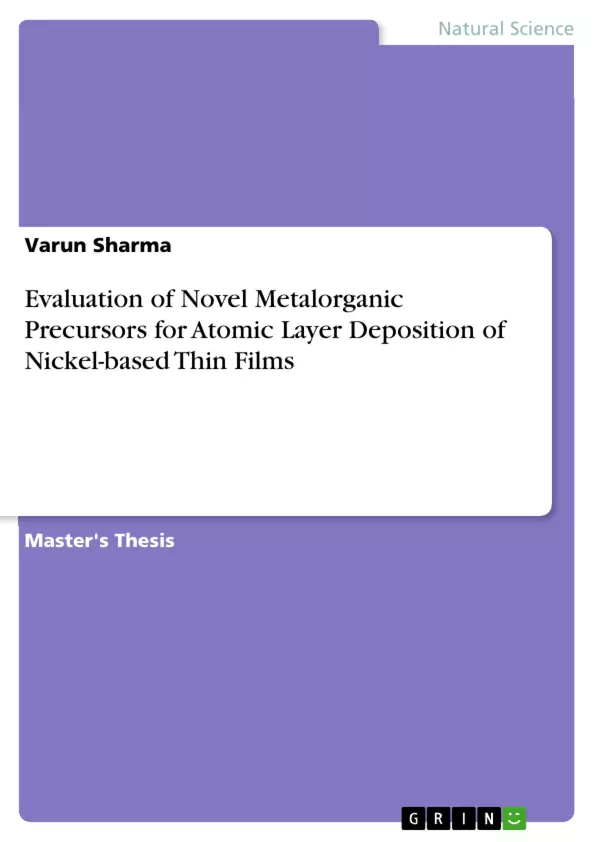Nickel and nickel(II) oxide are widely used in advanced electronic devices. In microelectronic industry, nickel is used to form nickel silicide. The nickel mono-silicide (NiSi) has emerged as an excellent material of choice for source-drain contact applications below 45 nm node CMOS technology. As compared to other silicides used for the contact applications, NiSi is preferred because of its low resistivity, low contact resistance, relatively low formation temperature and low silicon consumption. Nickel is used in nickel-based rechargeable batteries and ferromagnetic random access memories (RAMs). Nickel(II) oxide is utilized as transistor gate-oxide and oxide in resistive RAMs.
Atomic Layer Deposition (ALD) is a special type of Chemical Vapor Deposition (CVD) technique, that is used to deposit very smooth as well as homogeneous thin films with excellent conformality even at high aspect ratios.
In spite of huge number of practical applications of nickel and nickel(II) oxide, a few nickel precursors are available for thermal based ALD. Moreover, these precursors have resulted in poor film qualities and the process properties were also limited. Therefore in this master thesis, the properties of various novel nickel precursors had to be evaluated. All novel precursors are heteroleptic (different types of ligands) complexes and were specially designed by the manufacturer for thermal based ALD of pure nickel with hydrogen as a co-reactant.
In order to evaluate the novel precursors, a new methodology was designed to test small amounts (down to 2 g) of precursors in a very time efficient way. This methodology includes: TGA/DTA curve analyses of the precursors, thermal stability tests in which the precursors (< 0.1 g) were heated at elevated temperatures in a sealed environment for several hours, deposition experiments, and film characterizations. The depositions were monitored with the help of in situ quartz crystal microbalance, while application related film properties like chemical composition, physical phase, thickness, density, roughness and sheet resistance were investigated with the help of ex situ measurement techniques. [....]
Inhaltsverzeichnis (Table of Contents)
- Evaluation of Novel Metalorganic Precursors for Atomic Layer Deposition of Nickel-based Thin Films
- Dedication
- Introduction
- Fundamentals of Atomic Layer Deposition
- Nickel Silicide
- Nickel Precursors and their Properties
- Experimental Setup and Characterization Techniques
- Results and Discussion
- Conclusion and Outlook
Zielsetzung und Themenschwerpunkte (Objectives and Key Themes)
This master thesis aims to evaluate the suitability of novel metalorganic precursors for the Atomic Layer Deposition (ALD) of nickel-based thin films. The focus is on investigating the properties of these precursors and their impact on the resulting films. The key themes explored in this thesis are:- Atomic Layer Deposition (ALD) of nickel-based thin films
- Evaluation of novel metalorganic precursors for ALD
- Characterization of deposited films using various techniques
- Feasibility study for nickel silicide formation
- Comparison with state-of-the-art processes and precursors
Zusammenfassung der Kapitel (Chapter Summaries)
- Introduction: This chapter provides an overview of the research topic, highlighting the importance of nickel silicide for advanced semiconductor technology and the need for novel ALD precursors. It also outlines the thesis's objectives and structure.
- Fundamentals of Atomic Layer Deposition: This chapter presents the basic principles of ALD, covering key aspects like self-limiting surface reactions, growth mechanisms, and advantages of the technique for thin film deposition.
- Nickel Silicide: This chapter discusses the properties and applications of nickel silicide, focusing on its importance as a contact material in advanced semiconductor devices. The chapter also explores different methods for nickel silicide formation.
- Nickel Precursors and their Properties: This chapter delves into the chemistry of various nickel precursors, including their structures, properties, and suitability for ALD. It discusses the factors influencing precursor selection for efficient thin film growth.
- Experimental Setup and Characterization Techniques: This chapter describes the ALD system used in the research, outlining the process parameters and the various characterization techniques employed for analyzing the deposited films. These techniques include Ellipsometry, Scanning Electron Microscopy, 4-probe electrical measurements, X-Ray Reflectivity, X-Ray Diffraction, and X-Ray Photoelectron Spectroscopy.
- Results and Discussion: This chapter presents and analyzes the experimental results obtained from the evaluation of different nickel precursors. It explores the influence of precursor properties and process parameters on the quality and properties of the deposited nickel films. The chapter also discusses the feasibility of forming nickel silicide using the ALD approach.
Schlüsselwörter (Keywords)
This work focuses on Atomic Layer Deposition (ALD) of nickel-based thin films using novel metalorganic precursors. The primary focus is on evaluating the properties of these precursors and their impact on the resulting film quality. Key terms include ALD, nickel precursors, thin film deposition, nickel silicide, film characterization, and feasibility study.- Quote paper
- M.Sc. Nanoelectronic Systems Varun Sharma (Author), 2015, Evaluation of Novel Metalorganic Precursors for Atomic Layer Deposition of Nickel-based Thin Films, Munich, GRIN Verlag, https://www.grin.com/document/294280



